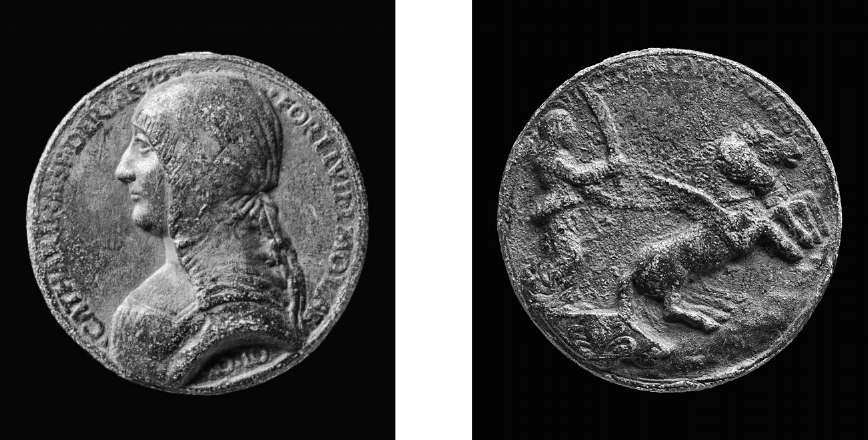The Tigress of Forli (21 page)
Read The Tigress of Forli Online
Authors: Elizabeth Lev

Monday, April 14, was a market day. The main square of Forlì was packed with artisans and farmers hawking their goods. The Forlivesi strolled through the square, buying necessities and admiring luxuries. The local barber and diarist Andrea Bernardi was in the middle of the fray, giving shaves and haircuts. Together with Leone Cobelli's, Bernardi's chronicles allow the modern reader to feel present at these events. The steady bustle and chatter of the square died down at lunchtime, and by the time Girolamo was ready for his brief repose, the area had emptied; only those packing up carts and cleaning away debris were left. Caterina and the children were dining in the
tinello,
a room off the kitchen close to the tower of the palace. As Girolamo stretched out on a bench, young Gasparino went to the window and waved his cap. Giacomo del Ronche saw the signal and quickly informed the others. The time had come.
The band of six Orsis, all clad in armor, joined Ludovico Pansecho and Ronche outside the palace. They climbed the main stairs leading to the Hall of the Nymphs. As arranged, Checco entered first, armed with his excuse for the intrusion. Girolamo had awakened and was conversing with his chancellor, Giovanni da Casale, and Corrado Feo, a distant relative. A liveried manservant was preparing the count for his afternoon audiences. Leaning lazily against the windowsill, Girolamo turned as Checco crossed the threshold into the room and asked, "What brings you here, my Checco?"
As if announcing glad tidings, the assassin reached into his pocket as he said, "I want to show you this letter from my friend. Soon I will have the money to pay you." In one smooth gesture, Checco drew a dagger from the folds of his cloak and struck the count on the right side of the chest. Girolamo jerked back with a shout and turned to run toward Caterina's rooms near the safety of the tower. Just then Pansecho and Ronche dashed into the room, seizing Girolamo by the hair and throwing him to the ground. As he lay prone, feebly trying to resist his assailants, they delivered blow after blow, reducing Caterina's plump husband to a mass of ragged flesh. The conspirators' shouts of "Liberty! Liberty!" summoned the Forlivesi, while the entire palace shook with combat. Darting up the main stairs, the Orsis' followers met Andrea Ricci, son of Domenico, who was engaged to Caterina's sister Stella. Andrea tackled Checco's son, Agamenone. Andrea got the better of his adversary, who died of his wounds twelve days later. Ludovico Orsi turned to fight off Andrea as he tried to enter the Hall of the Nymphs. When Andrea da Parma, one of Girolamo's personal guards, poked his head into the room to see what had befallen the count, it was struck and nearly cleaved in two by Checco's sword. The Forlì chief of police, Antonio da Montecchio, sprinted to the piazza but never made it up the stairs. Not content with killing him, the vicious attackers burned off all his hair, which had been his great pride. Even Caterina's jester Grego got into the fray, poking and jabbing with his dagger, but was no match for the professional men-at-arms and was killed immediately.
The bewildered townspeople crowded into the square, unable to ascertain if their lord was dead or alive. Instead of rallying in support of the Orsis, they argued among themselves, debating whether the count had been killed or wounded or had escaped altogether. Through the palace doors, they could see the fighting. Some yelled from a side street that the countess and her children were at another window, crying for help. Resolving the doubts of the people, three soldiers grasped Girolamo's battered, naked corpse and threw it over the balcony into the square. The horrified Forlivesi circled the barely recognizable body; discerning the facial features of the count, they knew that he was dead. They then raced into the palace.
The frescoed walls of the Riario home were already pockmarked by swords and smeared with blood, but worse was to come as rioters spread through the rooms. The house was ransacked; silver plate, jewels, bedding, and furniture disappeared into the greedy hands of the mob, leaving the denuded palace bereft of its owners and its adornment.
Girolamo lay in the piazza like a piece of meat discarded at the market: the corpse was dragged through the square, then kicked and spat upon. A few fanatics tried to tear the body to shreds, but the slow chant of the confraternity of the Battuti Neri processing into the square dispersed them. No one approached the Battuti Neri in their white hoods and robes as they silently ministered to the lifeless count. Loading the bedraggled remains of Girolamo into their cart, they carried him off, "pissing blood," to the cathedral. But the principal religious authorities of Forlì would not take the body in. They had received great benefits from Girolamo, but they were afraid of provoking a battle inside the church. Thus turned away, the brothers did as they would with the body of a criminal or an unclaimed murder victim found in a field. The Battuti laid the count in the sacristy of their own church, which was dedicated to Saint Francis. Forty-five-year-old Girolamo Riario, lord of Forlì, captain of the papal army, was dead; his tumultuous career ended with a creak as the lid of the cheap wooden coffin was nailed shut.
Caterina, who had been dining with her family in her rooms, assumed the worst when she heard the shouts of "Liberty!" She quickly gathered her family in a defensible room in the tower and dashed to the window with Ottaviano, calling for help for the heir to Forlì. But the palace was in the hands of the Orsis and their henchmen, and no help could reach the Riarios. Caterina looked at the pale, frightened faces gazing up at her. Her six childrenâfrom nine-year-old Ottaviano to the infant Sforzino in his nurse's armsâwere crying. Scipione, Girolamo's illegitimate son, who was now fourteen, put on a brave face, but he was still absorbing the shock of his father's murder. Caterina's mother, Lucrezia, and her sister Stella were also present, looking to her for guidance. Caterina knew what was at stake. The smartest move for the assassins would be to kill her and Ottaviano next, thus removing the heirs. Caterina barricaded the door to buy herself some precious time. From the window she called out to her loyal followers that it was useless to fight now, since her family was outnumbered and the Orsis had control of the palace. By then, the attackers had reached the inner court and were enraged to find the way blocked. As her words were punctuated by the blows at the door, she hastily issued instructions to a faithful retainer, Ludovico Ercolani, to get word to the Bentivoglios of Bologna and, most important, to her brother, the duke of Milan. The battering continued, marking the seconds she had left before capture. Caterina ordered all those who were loyal to her to meet in the fortress of Ravaldino. Under no circumstances could the castle be surrendered to the rebels. As the door splintered and burst open, Caterina spun away from the window and took her position among her family as the widow of Forlì.
 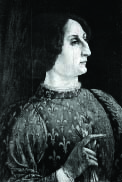
Portrait of Galeazzo Maria Sforza
, Piero del Pollaiuolo, 1471
This portrait of Caterina's father, the duke of Milan, was painted in 1471 during the duke's state visit to Lorenzo de' Medici, which was the first time Caterina saw Florence.
 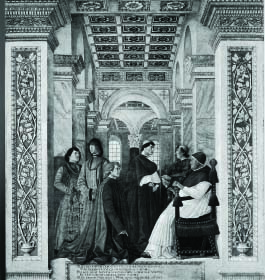
Sixtus IV Appoints Bartolomeo Platina Prefect of the Vatican Library
, Melozzo da Forlì, c. 1477
This, the earliest surviving ceremonial portrait of a papal family, contains images of the most important members of Sixtus's court. Pope Sixtus is seated on the right, with Cardinal Raffaello Riario next to him. Facing the pope is Cardinal Giuliano della Rovere; Platina kneels in the foreground. Girolamo Riario, Caterina's first husband, stands above Platina, and next to him on the far left is Giovanni della Rovere.
 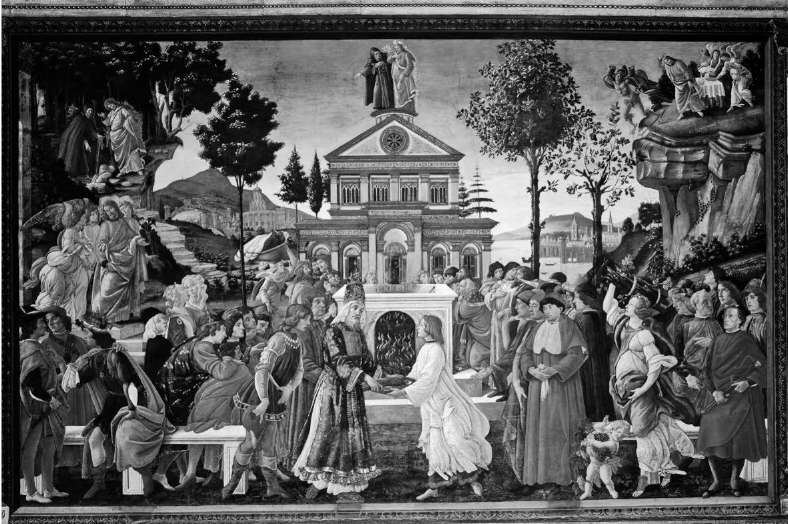
Detail from
The Purification of the Leper
, Sandro Botticelli, 1481
This fresco was painted to face the papal throne in the Sistine Chapel; it features members of Pope Sixtus's family. Caterina is on the far right, pregnant and carrying firewood, while her son Cesare fends off a viper at her feet. The cardinal holding the handkerchief is Giuliano della Rovere, Caterina's cousin by marriage.
 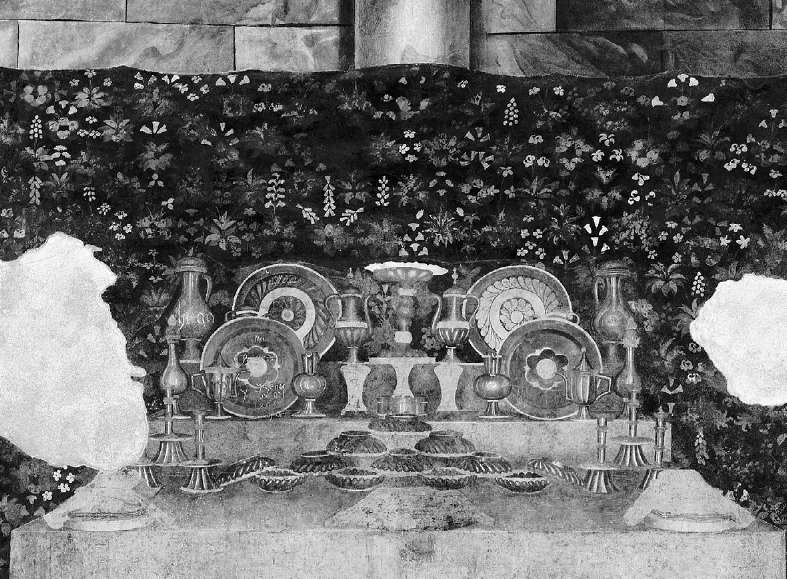
Fresco fragment from the
Sala della Piattaia
in the Altemps Palace, Melozzo da Forlì, c. 1479
This image is all that remains of the decoration of the main hall of Girolamo and Caterina's home in Rome. It illustrates the elaborate silver service given to the Riarios at their wedding in 1477.
 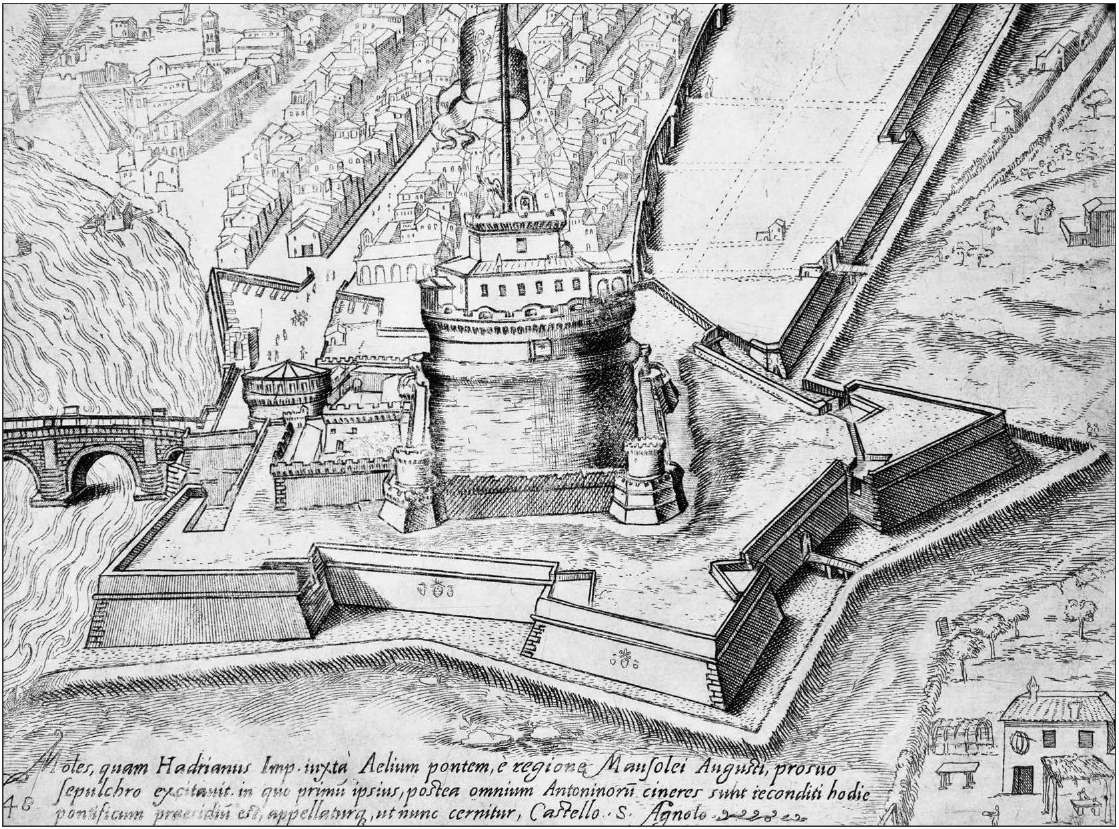
Etching of the tomb of Hadrian on the Tiber River, Giovanni Antonio Dosio, sixteenth century
The ancient imperial mausoleum was known in Caterina's day as the Castel Sant'Angelo. Used as a fortress and prison since the tenth century, the defenses shown in the drawing were constructed by Pope Alexander VI and his son Cesare Borgia.
 